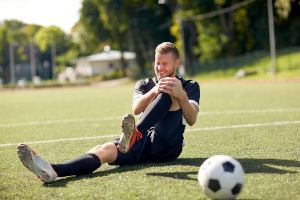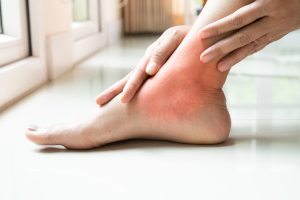Understanding Sports Injuries
Most sports injuries to joints occur because the joint was unable to respond appropriately at the time of injury. The extent of the injury is largely determined by how much dysfunction there was in the body prior to injury. That means that participating in sports while you are already injured, sore, fatigued, stressed out, or haven’t eaten makes it more likely that you’ll be injured. Unfortunately, not all treatment programs help people completely recover from injuries nor do they teach them how to adequately decrease the likelihood of future injuries.
In a typical sports injury, the injured area suffers from inappropriate muscle response rates that do not allow the muscle to protect the joint at the time of injury. This is NOT merely a function of how strong the muscles are, but more so whether they are responding at an appropriate rate. Once the muscle function is compromised, excess strain is placed on the ligaments to maintain joint integrity. The damage to the ligaments is the hallmark of a sprained joint. If the ligaments are not able to adequately protect the joint, then dislocation or fracture may occur. Simply put, the severity of most sports injuries to joints are determined by muscle function, not strength, the ability of the ligaments to withstand strain, and finally bone health.
Our Sports Injury Evaluation:

Common Sports Injuries We Can Help With

Sports Injury Services
Recovery from a sports injury requires three main components to heal. The amount of time for each step will be different depending on the severity of the injury & stability of the joint.
Step 1- Metabolic Support
Step 2- Muscle dysfunction
Step 3- Muscle strengthening
Step 2- Muscle dysfunction, Joint Support, Pain Reduction
Step 3- Muscle strengthening
This is where your typical healing journey begins with most physicians, chiropractors, physical therapists, and trainers. In some cases, this is a step that can be managed and supported at home with an at-home exercise program. Your ability to successfully build strength without damaging your body or predisposing it to further injury is often dependent upon your success in Steps 1 & 2. That being said, even if you have already began to perform strength building exercises, it is not too late to re-evaluate Steps 1 & 2 to ensure that your likelihood of re-injury decreases further and your ability to recover improves. My goal is to support your recovery process, not take it over if you already have help. During Step 3 exercises, it is important to pay attention to your performance. If you are not able to recover quicker in between exercises as you proceed with a program, or you are not able to consistently improve without set-backs you need to evaluate Steps 1 & 2 to find out why.
Fees For Services Provided
Sports Injury Office Hours
Monday: 3:30PM – 5:30PM
Wednesday: 3:30PM – 5:30PM
Friday: 9:00AM – 5:00PM
Services provided by appointment only. Walk-Ins are booked for a later date. Please call with any questions regarding time, services, or fee schedule. Insurance is not accepted by this office for these services, however, you may submit your receipt for any reimbursements directly to your insurer according to your policy.
How We Help People Get Better @ Lucid Force Health Center (LFHC)
Healthy diet and lifestyle choices lay the foundation for good health and recovery from all disease. At Lucid Force Health Center, our focus is on helping you rebuild your health by teaching you how to care for YOUR body so that you can get your life back and get rid of your symptoms. We use specialized lab testing to help identify other problems that have been robbing you of your health, but because there are not medications to fix them…your doctors don’t run the tests and often don’t know how to correctly interpret the results to help you. By looking for health versus disease, we can help guide you back to your Path To Health, so that you can fulfill your life’s purpose, pursue your dreams, and serve your family & community at a higher level!
Learn more about LFHC, or about conditions we help people with, how we look at lab tests differently, and how to be successful at getting your health back.





 Lucid Force Health Center
Lucid Force Health Center